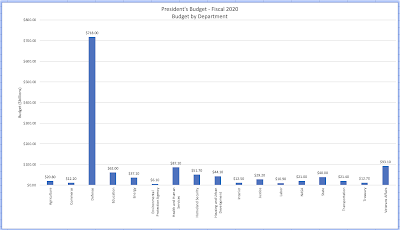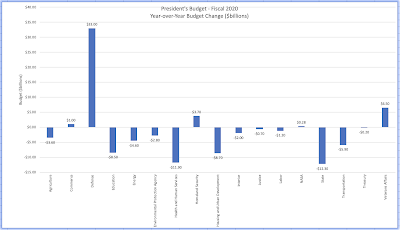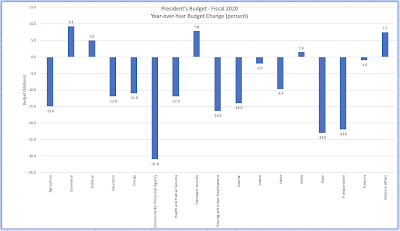
The recently released Presidential budget for fiscal 2020 clearly provides us with a list of the priorities of the current administration. Let’s look at some of the details.
Here is a graph showing the proposed budget (in billions of dollars) for all of the federal government departments and some key agencies:
Here is a graph showing the year-over-year changes in the budget for each federal government department, again in billions of dollars:
Here is a graph showing the year-over-year percent changes in the budget for each federal government department:
As you can see, the White House has prioritized Defense, Homeland Security and Veterans Affairs by increasing their budget allocations, whereas socially important departments with larger budgets like Health and Human Services and Education have seen their allocation of tax dollars reduced by 12 percent or a total of $20.4 billion. In the case of Health and Human Services, the budget for 2020 proposed $1.248 trillion in mandatory health savings as a mean to reduce long-term deficits.
On an overall basis, here is what is expected to happen to the deficits over the next 10 years:
Here is a table showing receipts, outlays and the debt and deficit over the next 10 years as well as the size of the economy (not allowing for any recessions):
Note that the debt held by the public-to-GDP ratio does not project any recessions over the period from 2019 to 2029, a highly unlikely scenario. As well, debt held by the public is only part of Washington’s debt; according to this Debt Position and Activity Report from the Treasury Department shows that the total debt is $22.115 trillion and is made up of $16.25 trillion (73.48 percent) in debt held by the public and $5.864 trillion (26.52%) in intergovernmental debt:
When both factors are taken into account, it suggests that Washington’s total debt will significantly exceed 100 percent over the next decade. As well, there could be significant negative impacts to the economy as Washington’s federal debt grows past the comfort zone of investors who will expect higher returns on what they may deem as riskier debt, a factor that will put upward pressure on debt servicing costs and, ultimately, the debt and deficits.
Let’s close with this interesting excerpt from the Department of Defense section of the budget:
“The Budget fully supports the U.S.-Israel Memorandum of Understanding and includes $3.3 billion in Foreign Military Financing grant assistance to bolster Israel’s capacity to defend itself against threats in the region and maintain its qualitative military edge.”
It’s interesting to see that Israel still benefits from Washington’s beneficence even as American taxpayers are expected to make do with less. No one doubts that there is a lot of waste in government but, a department with a proven track record of waste, still accounts for the lion’s share of the total funds being spent by the federal government.
Click HERE to read more from this author.
You can publish this article on your website as long as you provide a link back to this page.







Be the first to comment